Abstract
Background:
Controversial results have been reported concerning the influence of calcium intake on prostate cancer risk. The aim of this study was to determine any association between total calcium (in the diet and in supplements) intake and prostate cancer.
Materials and Methods:
The present systematic review and meta-analysis study was carried out following a PRISMA guidelines. Two reviewers independently using MeSH keywords searched international databases including PubMed, Science Direct, Cochrane, EMBASE, Web of Science, CINAHL, EBSCO and search engines such as Google Scholar. The searches were performed without any time limit until May 2016. The results were pooled using a random effects model and homogeneity was confirmed using the Q test and I2 index. Subgroup analyses was performed according to continents and study designs. The data were analyzed using STATA software version 3.2, with p<0.05 considered significant.
Result:
Overall, 12 studies with a total sample size of 905,046 were entered into the final meta-analysis. The main age range of the participants was 50 to 70 years. The relative risks (RR) for total calcium with total prostate cancer, localized prostate cancer, and advance prostate cancer were estimated to be 1.15 (95% CI: 1.04-3.46), 1.05 (95% CI: 0.96-1.14), and 1.15 (95% CI: 0.89-1.50), respectively. Only the relationship between total calcium and total prostate cancer was significant (P<0.05).
Conclusions:
High calcium intake can be considered as a risk factor for total prostate cancer. Therefore, calcium intake might be a target for prevention.
Keywords: Calcium, prostate cancer, systematic review, meta-analysis
Introduction
Prostate cancer is a disease in which malignant cells originate from the prostate tissues. They regularly and increasingly expand and lead to an increased volume in each of the cellular components of the prostate gland. It is among the most common diagnostic neoplasm in men and the second leading cause of death from cancer following lung cancer. The incidence of this disease significantly increases after 65 years of age. Prostate cancer is the most common malignancy in America, Canada and the sixth known cancer in the world. Its incidence and prevalence rates vary in different parts of the world. In the United States of America, itis the most common cancer in men (Butler et al., 2010; Yavari, 2013-2014). It is also the second leading cause of cancer deaths among men in the United States of America. No comprehensive investigation on prostate cancer epidemiology has been carried out in Iran. In cancer recording projects, some have ranked it fifth and others ranked it’s the ninth type of cancer among Iranian males. Sajadiet al. in a study conducted in five provinces Iran reported the annual incidence rate of this disease 5 per 100,000 persons and observed no difference among the aforementioned provinces (Yavari, 2013-2014). There are four types of prostate cancer. Total prostate cancer refers to all types of prostate cancer. Advance prostate cancer means that the cancer has spread outside the prostate capsule. The type of cancer is also known as metastatic cancer and it is often observed in bones and lymph nodes. Localized prostate cancer only affects a part of the prostate. Fatal prostate cancer is the leading cause of death. Some studies have shown that the possible impact of diet is associated with increased risk of prostate cancer (Wiseman, 2008). Based on clinical and laboratory documents, high intake of calcium and dairy products may increase the risk of developing prostate cancer by suppressing the production of 1,25 Dihyroxy Vitamin D3 (the active form of vitamin D3) which is independent from the Vitamin D receptors (Yavari, 2013-2014); (Ahn et al., 2007); (Park et al., 2007). Furthermore, ecological studies have reported a high correlation between calcium intake and prostate cancer risk (Ganmaa et al., 2002; Zhang and Kesteloot, 2005; Grant, 1999). But nother studies were reported not correlation between calcium intake and prostate cancer risk (Butler et al., 2010; Ahn et al., 2007; Park et al., 2007). A systematic review and meta-analysis study with the reviewing all documents related to a specific topic can be presented overall estimation and complete picture of the problem (Rahmati et al., 2017; Azami et al., 2017). Regarding the fact that many studies have been carried out on the relationship between total calcium and prostate cancer over the world and a number of studies have shown that calcium increases the risk of prostate cancer; however, the relationship was not significant in other studies and considering the increasing importance of the issue and high mortality rates; a systematic review and meta-analysis can put all documentation together to provide a more accurate picture of the problem in the world. The aim of this study was to determine the relationship between total calcium (diet and supplements) and prostate cancer in the world and to examine its general trend in the world by a systematic approach and meta-analysis.
Materials and Methods
Search Strategy
The current study was conducted based on the preferred reporting items for systematic reviews and meta-analyses (PRISMA) (Moher, Liberati, Tetzlaff, Altman, and Group, 2010). Two reviewers independently using keywords (“Calcium”[MeSH] and “Prostatic Neoplasms”[MeSH]) searched international online databases including PubMed, Science Direct, Cochrane, EMBASE, Web of Science, CINAHL, EBSCO and search engine such as Google Scholar search engine. The searches were performed without any time limit until May 2016. Moreover, the articles” references were also examined for further studies.
Study Selection
First, all related articles (the relationship between total calcium and prostate cancer) were collected a, a list of titles and abstracts of research studies were prepared by the researchers in databanks and duplicate studies were removed.
After blinding the article’s specifications (including the name of the journal and the name of the authors) by the researcher (Shoboo Rahmati), the full text of the articles was presented to the researchers (Milad Azami and Mohammad Reza HafeziAhmadi). If the article was rejected, the reason for this was noted. In the event of a dispute between the two authors, this paper was evaluated by a team of researchers.
Quality assessment
Two researchers independently examined the selected articles using an adapted version of Newcastle Ottawa Scale (NOS) for Cohort Studies and also NOS for case-control studies (Wells et al., 2010), which is a standard and an international checklist for the quality assessment of the studies. The articles that received threshold score of qualitative evaluation were enrolled in the meta-analysis process.
Inclusion and exclusion criteria
Inclusion criteria in the present study, including: Studies in which the relationship between total calcium (diet and supplements) and prostate cancer was identified, Availability of full text articles, Observational epidemiological studies and Articles was published and indexed in English abstract. Exclusion criteria include studies: prostate cancer not event as outcome and Low quality studies.
Data Extraction
To reduce the bias and errors in data collection, data extraction was independently done by two researchers using data extraction form (name, author, year of publication, country, continent, number of participants, number of follow-up years, sex, age, exposure assessment, type of exposure, dose, Relative risks (RR) or odds ratio (OR), CI (confidence interval) and matched variables). If you need to have specific questions or ambiguous articles, the author via e-mail questions need to be asked. For further information and in the case of having questions, contact the corresponding author. Information extracted by two researchers was compared and the differences were discussed. These differences were also shared by a third person and finally a consensus was reached by re-examining and comparing the obtained results.
Outcomes of Interest
The outcome of interest included prostate cancer, total prostate cancer, localized prostate cancer, advance prostate cancer, and fatal prostate cancer.
Statistical Analysis
Prostate cancer was categorized in to total prostate cancer, localized prostate cancer, advance prostate cancer, and fatal prostate cancer and their relationship with total calcium was analyzed. However, the relationship between total calcium with fatal prostate cancer was not analyzed because there were only three studies assessing this relationship. In order to analyze the subgroups, follow-up years were divided into two groups: less than 10 years and more than 10 years. The dose was divided into two groups: less than 750 mg/day and more than 750 mg/day. Furthermore, to evaluate the effect of total calcium in relation with different types of prostate cancer, the relative risk index and to evaluate the heterogeneities, the (I2) index and Q statistic were used. I2 index is an index that shows heterogeneities among studies, I2 less than 25% show low heterogeneities, %25 < I2 < 75% moderate heterogeneity, and I2 > 75% high heterogeneity. When Q statistics was significance we used random effect models. For the heterogeneity of studies, the random effect model was used to combine the study’s results. In every study, RR or OR extracted the lower and higher limit. In studies that this index was not extracted, it was calculated through OR=ad/bc (Articles that had not the OR to use the formula) and the logarithm of OR or RR was used to polarize the effect size. Error standard was calculated by SE= 1n (upper 95% CI / lower 95% CI) / (2× 1.96). If only upper and lower limit had been reported in studies, OR= ad/bc was used. Meta-regression was used for evaluating the relation between year of study and effect size and evaluating the cause of heterogeneity of studies. Begg’s funnel plot was used to investigate publication bias and sensitivity analysis was performed to evaluate the effect of each study on the overall results. STATA software version 3.2 was used to analyze in this study and P<0.05 has been considered significance level for all analyzes.
Results
Literature Search result and characteristics of studies
A total of 165 articles were identified from the database search by two authors and 11 studies were excluded due to duplication. After screening the titles and abstracts, 120 studies were excluded because of their irrelevance to the topic. Finally, 12 studies (including 11 cohort studies and 1 case control study) with appropriate quality entered the meta-analysis (Figure 1).
Figure 1.
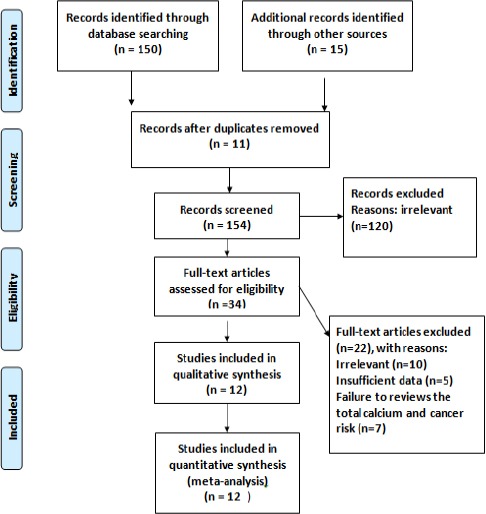
Entry Procedures of Studies to Meta-analysis
The average age of majority was between 50 -70 years and also about 83%of articles had been performed in the USA (Table 1).
Table 1.
Characteristics of Studies Entered to Meta-Snalysis
| author -publication year-reference | continent | Design | (years) | Sample size | Age | Dietary assessment | PC stage or grade | Exposure | Quantity | RR (95% CI) | Adjustment for confounders |
|---|---|---|---|---|---|---|---|---|---|---|---|
| (Butler et al., 2010) | Asia | Cohort | 11 | 27293 | 45-75 | FFQ | -Total pc -Localized pc -Advance pc |
Total calcium | 659 vs, 211mg/day | 1.25 (0.89-1.74) -1.43 (0.81-2.52) -1.18 (0.75-1.87) |
Age, dialect group, interview year, education, weekly supplement use |
| (Ahn et al., 2007) | USA | Cohort | 8.9 | 29509 | 55-74 | FFQ | -Total pc -Localized pc -Advance pc |
Total calcium | >2001vs, <750mg/day | -0.89 0.66-1.19) -1.08 (0.75-1.56) -0.61 (0.37-1.02) |
Age, race, study center, FH–PC, BMI, smoking status, physical activity, diabetes history, red meat, total energy, education, no. of screening examinations during followup |
| (S.-Y. Park et al., 2007) | USA | Cohort | 6 | 293888 | 50-71 | Validated FFQ | Localized pc -Advance pc -Fatal pc |
Total calcium | >2000vs, <250mg/day | -0.93 (0.81-1.07) -1.20 (0.86-1.67) -1.05 (0.54-2.05) |
Age, race/ ethnicity, education, marital status, BMI, vigorous physical activity, smoking, alcohol consumption, diabetes history, FH–PC, PSA screening, tomatoes, red meat, fish, vitamin E, ALA, total Energy…. |
| (Giovannucci, Liu, Platz, Stampfer, and Willett, 2007) | USA | Cohort | 16 | 47750 | 45-70 | Validated FFQ, 131 food items | -Total pc -Localized pc -Advance pc Fatal pc |
Total calcium | >2000vs, 500-749mg.day | -1.28 (1.02-1.60) -1.13 (0.88-1.47) -2.02 (1.28-3.19) -2.02 (1.14-3.58) |
Age, time period, BMI at age 21 y, vigorous physical activity, height, cigarette packyears in the previous 10 y, FH–PC, diabetes, total calories, red meat, fish, ALA, zinc supplements, tomato sauce |
| (Rohrmann et al., 2007) | USA | Cohort | 13 | 3892 | >35 | FFQ, 110 items | -Total pc -Localized pc -advance pc |
Total calcium | >957vs, <685 mg/day | 0.99 (0.70-1.41) -1.16 (0.63-2.15) -1.06 (0.55-2.04) |
Age, energy intake, tomato products, BMI at age 21 y, SFA |
| (Rodriguez et al., 2003) | USA | Cohort | 7 | 65321 | 50-74 | Validated FFQ, 68 food items | Total pc Advance pc | Total calcium | >2000vs, <700 mg.day | 1.2 (1-1.6) 1.6 (0.9-3) | Age at entry, race, FH–PC, total energy, total fat intake, education, phosphorus, total vitamin D |
| (Wilson, Shui, Mucci, and Giovannucci, 2014) | USA | Cohort | 16 | 47885 | 49-75 | FFQs with more than 130 food items | Total pc -Localized pc -Advance pc -Lether pc |
Total calcium | >2000 mg.day | 1.24 (1.02-1.51) -1.07 (0.82-1.39) -1.49 (1.01-2.20) -1.66 (1.09-2.53) |
Age-BMI-race-smoking-diabetes-family history |
| (Rowland, Schwartz, John, and Ingles, 2012) | USA | Case-control | - | 783 | - | Total pc | Total calcium | >1059 mg.day | 2.20 (1.40-3.46) | - | |
| (Kesse et al., 2006) | Europe | cohort | 7.7 | 2776 | 45-60 | 5 3 24-h dietary Record | -total pc | Total calcium | >1081vs, <725 mg.day | -2.43 (1.05-5.62) | Age, energy intake, tomato products, BMI at age 21 y, SFA |
| (Y. Park et al., 2007) | USA | cohort | 8 | 82483 | 45-75 | Validated FFQ, $180 food items | -Total pc -Localized pc -Advance pc |
Total calcium | >1301vs, <470 mg.day | 1.04 (0/91-1.20) -1.10 (0.94-1.29) -0.91 (0.65-1.28) |
Age, time since cohort entry, ethnicity, FH– PC, education, BMI, smoking status, energy intake |
| (Qin, He, and Xu, 2009) | USA | cohort | 8 | 293907 | 50-71 | Validated FFQ | Total pc | Total calcium | 1530vs,526mg/day | 1.03 (0.98-1.08) | Age, raceethnicity, education, marital status, BMI, FH– cancer, diabetes, physical activity, ALA, alcohol, red meat, total energy, smoking, PSA test, tomatoes, selenium |
| (Kristal et al., 2010) | USA | Cohort | 7 | 9559 | >55 | FFQ | Total pc | Total calcium | >1357vs,<689mg/day | 1.17 (0.97-1.42 | Age, raceethnicity, treatment arm, BMI, energy intake |
The relationship between calcium intake and total prostate cancer
The heterogeneity in the study was high (I2= 59.7%, P= 0.006). In eleven studies, the combined studies using random-effects model the relationship between calcium intake and total prostate cancer showed that calcium intake increases the prostate cancer risk with a RR of 1.15 (95% CI: 1.04- 1.27) (Figure 2-A).
Figure 2.
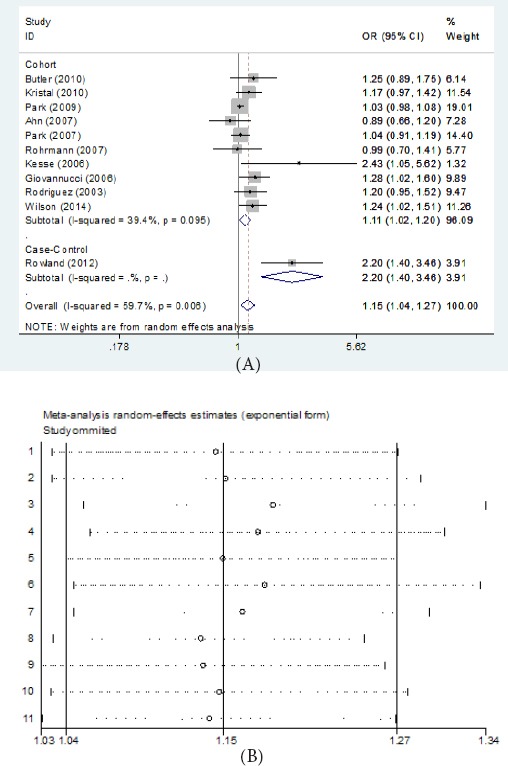
Forest Plot of Meta-analysis (A) and Sensitivity Analysis (B) for Relationship between Calcium Intake and Total Prostate Cancer
This relationship in cohort and case control studies was significant with RR of 1.11 (95% CI: 1.02-1.20) and OR of 2.20 (95% CI: 1.40-3.46), respectively (Figure 2-A).
Sensitivity analysis
Sensitivity analysis was performed on the impact of each study in overall results. Sensitivity analysis by removing one study at the same time was indicated that the overall RR was robust (Figure 2-B).
Subgroups analysis for relationship between calcium intake and total prostate cancer
Based on the continent
Nine, one, one study was conducted on the continents of America, Asia and Europe, respectively. RR with 95% CI for relationship between calcium intake and total prostate cancer in American, Asian and European studies was 1.13 (95% CI: 1.03-1.25), 1.25 (95% CI: 0.89-1.75), and 2.43 (95% CI: 1.05-5.62), respectively (Figure 3-A).
Figure 3.
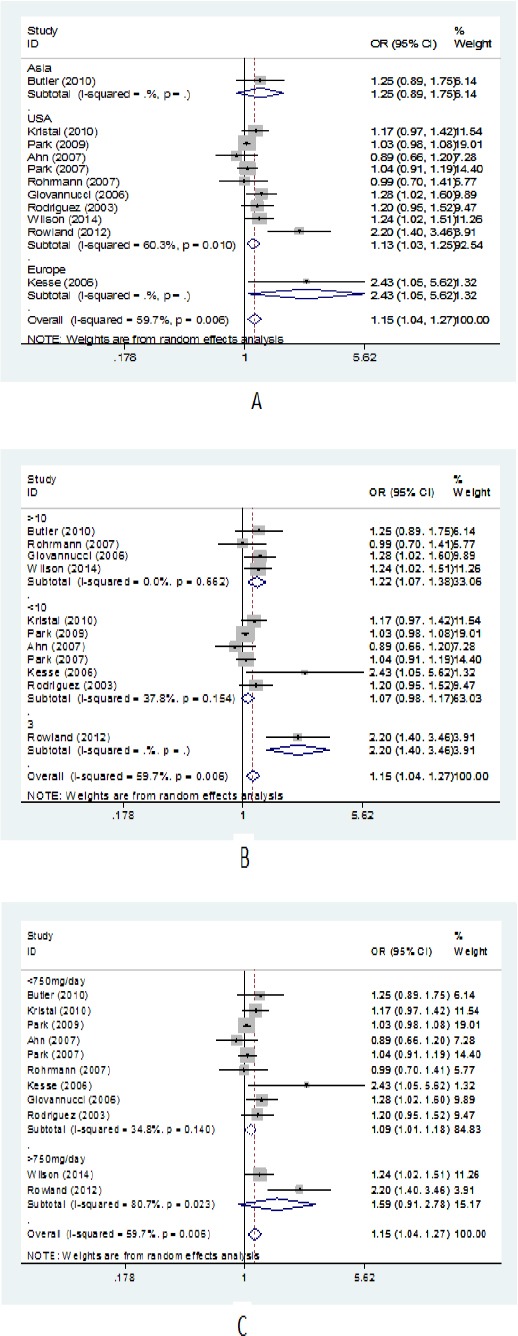
Forest Plot of the Subgroup Analysis Based on Continent (A), the Continent (B), Dose of Consumable (C) for Relationship between Calcium Intake and Total Prostate Cancer
Based on follow-up years
In studies with follow-up less and more than 10 years, the relationship between calcium intake and total prostate cancer was significant with the RR of 1.07 (95% CI: 0.98-1.17) and 1.22 (95% CI: 1.07-1.38), respectively (Figure 3-B).
Based on the dose of consumable
In nine studies with doses <750 Mg / day, the relationship between calcium intake and total prostate cancer was significant with the RR of 1.09 (95% CI: 1.01-1.18) and also in two studies with a dose > 750 Mg / day, this relationship was not significant with the RR of 1.59 (95 % CI: 0.91-2.78) (Figure 3-C).
Based on sample size and year of publication
According to the Table 2, there is no significant relationship between year of publication and the effect size logarithm and their regression equation is as follows: y=-35.32+0.01x (p=.04 for the line slop). There is also no significant relationship between sample size and the effect size logarithm and their regression equation is as follows: y = 0.22-7.64x (p=.03 for the line slop) (Table 2).
Table 2.
The Relationship between Calcium Intake and Total Prostate Cancer by Sample Size and Year of Publication
| Coefficient | Standard error | p | |
|---|---|---|---|
| Year of publication Cons | 0.01 | 0.02 | 0.4 |
| -35.32 | 48.38 | 0.4 | |
| Sample size Cons | -7.64 | 7.44 | 0.3 |
| 0.22 | 0.08 | 0.3 |
The relationship between total calcium and localized prostate cancer
In eight cohort studies, the relationship between total calcium and localized prostate cancer was not significant with the RR of 1.05 (95% CI: 0.96-1.14) (Figure 4).
Figure 4.
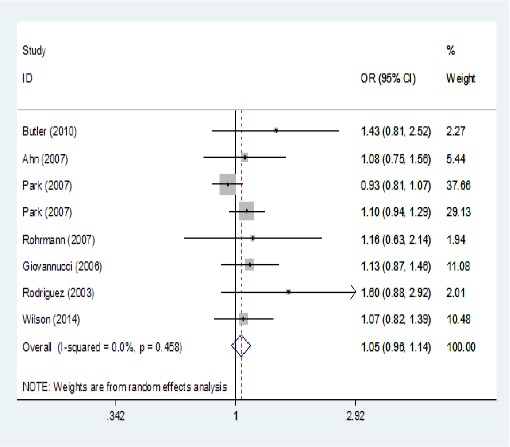
Forest Plot of the Relationship between Total Calcium and Localized Prostate Cancer
Subgroups analysis for relationship between total calcium and localized prostate cancer
Based on the continent
Seven and one study was conducted on the continents of America and Asia respectively. RR with 95% CI for relationship between total calcium and localized prostate cancer in Asian and American studies was estimated to be 1.43 (95% CI: 0.81-2.52) and 1.04 (95% CI: 0.95-1.13), respectively (Figure 5-A).
Figure 5.
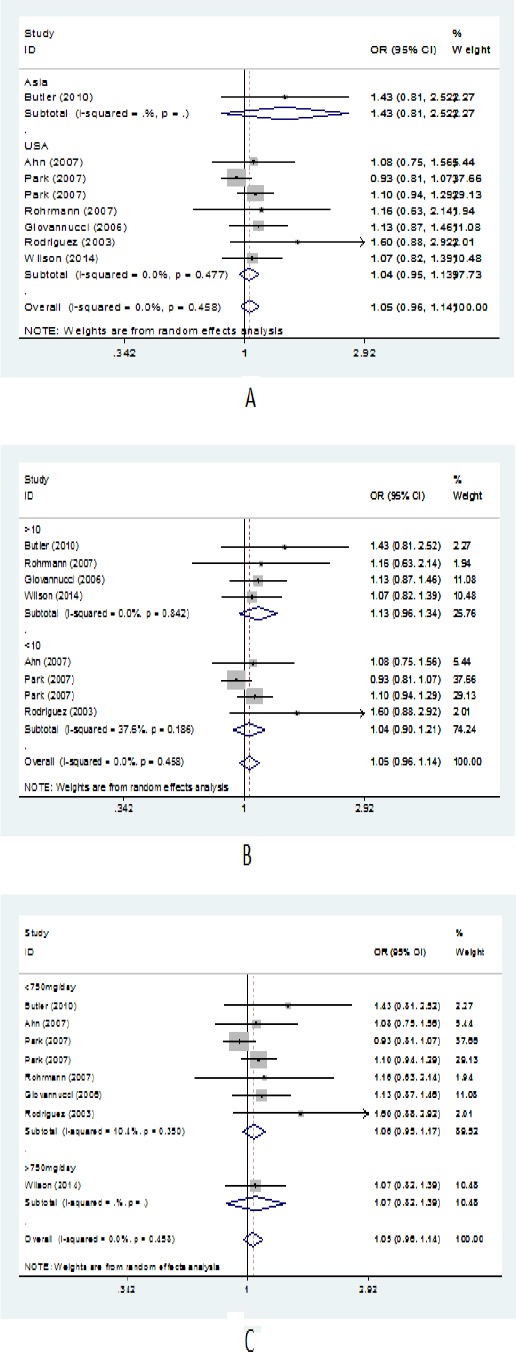
Forest Plot of Subgroup Analysis Based on the Continent (A), the Continent (B), Dose of Consumable (C) for Relationship between Total Calcium and Localized Prostate Cancer
Based on follow-up years
In studies with follow-up less and more than 10 years, the relationship between calcium intake and Localized prostate cancer was not significant with RR of 1.04 (95% CI: 0.90-1.21) and 1.13 (95% CI: 0.96-1.34), respectively (Figure 5-B).
Based on the dose of consumable
In seven studies with doses <750 Mg / day, the relationship between calcium intake and localized prostate cancer was not significant with the RR of 1.06 (95% CI: 0.96-1.17) and also in one studies with a dose > 750 Mg / day, this relationship was not significant with RR of 1.07 (95% CI: 0.82-1.39) (Figure 5-C).
Publication Bias
The Beggs Funnel Plot was used to study the publication bias. Begg’s test was showed the effect of publication bias was significant for relationship between calcium intake and total prostate cancer (P = 0.02) and the relationship between total calcium and localized prostate cancer (P = 0.03) (Figure 6).
Figure 6.
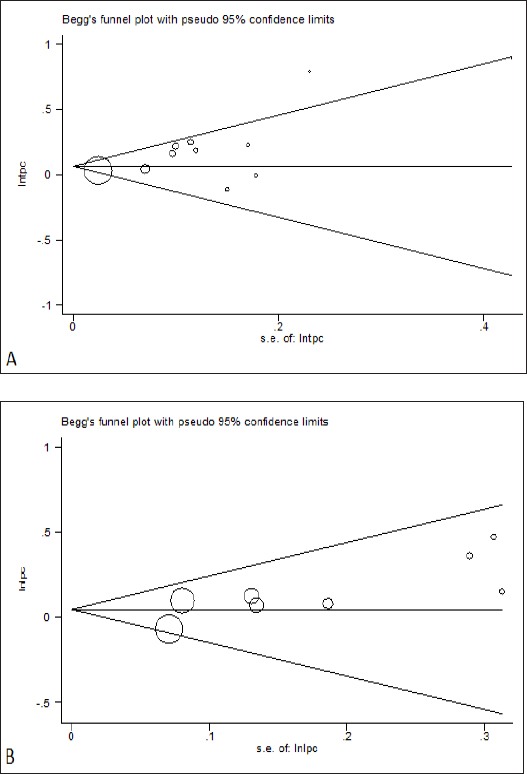
Forest Plot of Publication Bias for Relationship between Calcium Intake and Total Prostate Cancer (A) and Relationship between Total Calcium and Localized Prostate Cancer (B)
The relationship between Total calcium and Advance prostate cancer
In seven cohort studies, the relationship between total calcium and advance prostate cancer was not significant with the RR of 1.15 (95% CI: 0.89-1.50) (Figure 7).
Figure 7.
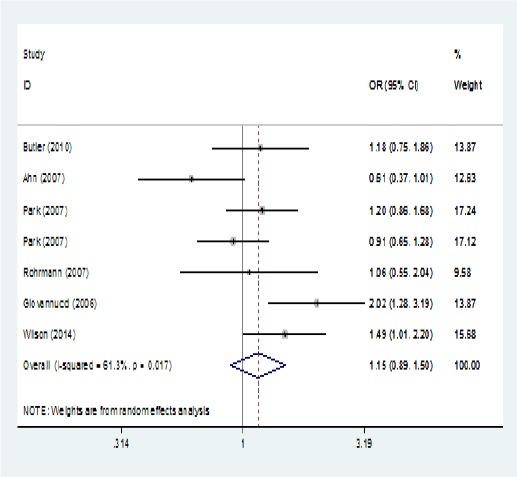
Forest Plot of the Relationship between Total Calcium and Advance Prostate Cancer
Subgroups analysis for relationship between total calcium and advance prostate cancer
Based on follow-up years
In studies with follow-up less than 10 the relationship between calcium intake and Advance prostate cancer was not significant with RR of 0.91 (95% CI: 0.64-1.29). In studies with follow-up more than 10 years, the relationship between calcium intake and Advance prostate cancer was significant with RR of 1.45 95% CI: 1.11-1.88) (Figure 8).
Figure 8.
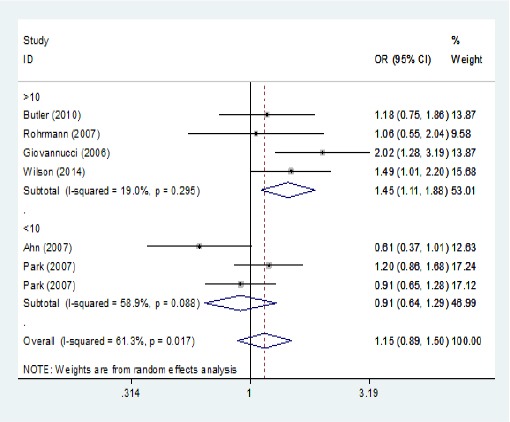
Forest Plot of Subgroup Analysis Based on the Continent Follow-up Years for Relationship between Total Calcium and Advance Prostate Cancer
Discussion
The results of the meta-analysis study strongly showed that total calcium intake increases total prostate cancer. The analyses of sub-groups also showed that this relationship mostly is observed in the continent USA. This relationship (total calcium and prostate cancer overall) can be mostly seen in the developed countries. Of course PSA testing is of great importance in the developed countries and most studies conducted in this continent. Therefore results of the present meta-analysis study consistent to study conducted by Anue et al., (2012). Giovannucci’s et al., (2007) study showed that total calcium intake increases prostate cancer risk (Ma et al., 2001).
Different studies showed that total calcium intake is mostly associated with total prostate cancer risk. In fact publication bias or small study effects can be a problem in meta-analysis of published articles and their estimation may be exaggerated. Moreover, limitations of this study include non-equal reporting of articles, publication biases, and non-publication of those articles which did not obtain a causal relationship. The assessment errors in assessing the amount of calcium were another limitation and mistake of this study. Calcium intake may be associated with other risk factors such as physical activity, smoking, alcohol consumption, meat and tomato consumption, or prostate-specific antigen (PSA) test (21, 22, 53, and 61). These risk factors act as confounding factors and the results vary in several sub-groups according to adjustment of these confounding variables.
In conclusion, results showed that total calcium intake increases the risk of total prostate cancer; however, there is a positive correlation between localized prostate cancer and advance prostate cancer, and the total calcium intake. According to the results based on the effect of calcium intake on increasing the risk of total prostate cancer, it is recommended that calcium supplements are prescribed in some cases considering their possible benefits and harms. Since no study has been conducted on the relationship between calcium intake and prostate cancer in Iran, further prospective epidemiologic studies are recommended.
Conflict of interest
The authors declare that they have no competing interests.
Acknowledgements
Hereby deputy university of Ilam medical science from professors who with their guidance of helped us and all of individuals who cooperated in the implementation of the plan our fullest appreciation and give thanks. The present study was supported by a Ilam University of Medical Sciences (grant number: 910582).
References
- 1.Ahn J, Albanes D, Peters U, et al. Dairy products, calcium intake, and risk of prostate cancer in the prostate, lung, colorectal, and ovarian cancer screening trial. Cancer Epidemiol Prev Biomarkers. 2007;16:2623–30. doi: 10.1158/1055-9965.EPI-07-0601. [DOI] [PubMed] [Google Scholar]
- 2.Aune D, Lau R, Chan D, Vieira R, Greenwood D, et al. Dairy products and colorectal cancer risk:a systematic review and meta-analysis of cohort studies. Ann Oncol. 2012;23:37–45. doi: 10.1093/annonc/mdr269. [DOI] [PubMed] [Google Scholar]
- 3.Azami M, Nasirkandy Mansouri A, Darvishi Z, et al. Global prevalence of helicobacter pylori infection in pregnant women:A systematic review and meta-analysis study. Int J Womens Health Rep Sci. 2017;5:30–6. [Google Scholar]
- 4.Butler LM, Wong AS, Koh WP, et al. Calcium intake increases risk of prostate cancer among Singapore Chinese. Cancer Res. 2010;70:4941–48. doi: 10.1158/0008-5472.CAN-09-4544. [DOI] [PMC free article] [PubMed] [Google Scholar]
- 5.Ganmaa D, Li XM, Wang J, et al. Incidence and mortality of testicular and prostatic cancers in relation to world dietary practices. Int J Cancer. 2002;98:262–67. doi: 10.1002/ijc.10185. [DOI] [PubMed] [Google Scholar]
- 6.Giovannucci E, Liu Y, Platz EA, et al. Risk factors for prostate cancer incidence and progression in the health professionals follow-up study. Int J Cancer. 2007;121:1571–8. doi: 10.1002/ijc.22788. [DOI] [PMC free article] [PubMed] [Google Scholar]
- 7.Grant W. An ecologic study of dietary links to prostate cancer. Altern Med Rev. 1999;4:162–9. [PubMed] [Google Scholar]
- 8.Kesse E, Bertrais S, Astorg P, et al. Dairy products, calcium and phosphorus intake, and the risk of prostate cancer:results of the French prospective SU. VI. MAX (Supplementation en Vitamines et Mineraux Antioxydants) study. Br J Nutr. 2006;95:539–45. doi: 10.1079/bjn20051670. [DOI] [PubMed] [Google Scholar]
- 9.Kristal AR, Arnold KB, Neuhouser ML, et al. Diet, supplement use, and prostate cancer risk:results from the prostate cancer prevention trial. Am J Epidemiol. 2010;172:566–77. doi: 10.1093/aje/kwq148. [DOI] [PMC free article] [PubMed] [Google Scholar]
- 10.Ma J, Giovannucci E, Pollak M, et al. Milk intake, circulating levels of insulin-like growth factor-I, and risk of colorectal cancer in men. J Natl Cancer Inst. 2001;93:1330–6. doi: 10.1093/jnci/93.17.1330. [DOI] [PubMed] [Google Scholar]
- 11.Moher D, Liberati A, Tetzlaff J, Altman DG, Group P. Preferred reporting items for systematic reviews and meta-analyses:the PRISMA statement. Int J Surg. 2010;8:336–41. doi: 10.1016/j.ijsu.2010.02.007. [DOI] [PubMed] [Google Scholar]
- 12.Yavari P. Epidemiology textbook of prevalent diseases in iran:Nasher Publication Gap. 2013-2014:127–30. [Google Scholar]
- 13.Park S-Y, Murphy SP, Wilkens LR, et al. Calcium, vitamin D, and dairy product intake and prostate cancer risk:the Multiethnic Cohort Study. Am J Epidemiol. 2007;166:1259–69. doi: 10.1093/aje/kwm269. [DOI] [PubMed] [Google Scholar]
- 14.Park Y, Mitrou PN, Kipnis V, et al. Calcium, dairy foods, and risk of incident and fatal prostate cancer:the NIH-AARP Diet and Health Study. Am J Epidemiol. 2007;166:1270–79. doi: 10.1093/aje/kwm268. [DOI] [PubMed] [Google Scholar]
- 15.Qin L-Q, He K, Xu J-Y. Milk consumption and circulating insulin-like growth factor-I level:a systematic literature review. Int J food Sci Nutr. 2009;60:330–40. doi: 10.1080/09637480903150114. [DOI] [PubMed] [Google Scholar]
- 16.Rahmati S, Delpishe A, Azami M, Ahmadi M, Sayehmiri K. Maternal anemia during pregnancy and infant low birth weight:A systematic review and Meta-analysis. Int J Rep BioMed. 2017;15:125. [PMC free article] [PubMed] [Google Scholar]
- 17.Rodriguez C, McCullough ML, Mondul AM, et al. Calcium, dairy products, and risk of prostate cancer in a prospective cohort of United States men. Cancer Epidemiol Prev Biomarkers. 2003;12:597–603. [PubMed] [Google Scholar]
- 18.Rohrmann S, Platz EA, Kavanaugh C, et al. Meat and dairy consumption and subsequent risk of prostate cancer in a US cohort study. Cancer Causes Control. 2007;18:41–50. doi: 10.1007/s10552-006-0082-y. [DOI] [PubMed] [Google Scholar]
- 19.Rowland G, Schwartz G, John E, Ingles S. Calcium intake and prostate cancer among African Americans:effect modification by vitamin D receptor calcium absorption genotype. J Bone Miner Res. 2012;27:187–94. doi: 10.1002/jbmr.505. [DOI] [PMC free article] [PubMed] [Google Scholar]
- 20.Wells GA, Shea B, Connell DO, et al. The Newcastle-Ottawa Scale (NOS) for assessing the quality of non randomised studies in meta-analyses. 2010. Available from:URL: http://www.ohri.ca/programs/clinical-epidemiology/oxford.asp .
- 21.Wilson K, Shui M, Mucci A, Giovannucci E. Calcium and phosphorus intake and prostate cancer risk:a 24-y follow-up study. Am J Clin Nutr. 2014;101:173–83. doi: 10.3945/ajcn.114.088716. [DOI] [PMC free article] [PubMed] [Google Scholar]
- 22.Wiseman M. The second world cancer research fund/American institute for cancer research expert report. food, nutrition, physical activity, and the prevention of cancer:a global perspective. Proc Nutr Soc. 2008;67:253–6. doi: 10.1017/S002966510800712X. [DOI] [PubMed] [Google Scholar]
- 23.Zhang J, Kesteloot H. Milk consumption in relation to incidence of prostate, breast, colon, and rectal cancers:is there an independent effect? Nutr Cancer. 2005;5:65–72. doi: 10.1207/s15327914nc5301_8. [DOI] [PubMed] [Google Scholar]


